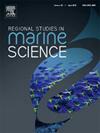基于层次分析法(AHP)的孟加拉国沿海脆弱性评估
IF 2.1
4区 环境科学与生态学
Q3 ECOLOGY
引用次数: 0
摘要
孟加拉国位于世界上最大的盆地之一恒河-布拉马普特拉河-梅克纳河(GBM)内,由于其地貌结构,孟加拉国经常遭受自然灾害。这条海岸线位于孟加拉国南部边缘,向孟加拉湾开放,经常遭受各种自然灾害。由于气候变化,孟加拉国的海岸线预计将随着时间的推移变得更加脆弱。因此,了解脆弱性的时空维度并加强沿海社区的复原力至关重要。本研究利用遥感和GIS技术,结合多准则决策(MCDM)和层次分析法(AHP),建立了孟加拉国海岸脆弱性指数(CVI)。AHP是在ArcGIS 10.5版本中进行的,使用了两个地质参数、五个物理过程变量和三个社会经济参数。使用ArcGIS为每个参数创建了几个专题地图,并根据漏洞排名进行了重新分类。最终,开发了一个CVI,将漏洞分为三类:中度脆弱、脆弱和高度脆弱。结果表明,约70 %的沿海地区属于易损区,29 %的沿海地区属于中高易损区。库尔纳区、萨特基拉区和博拉区的查尔法森约1%的地区被列为高度脆弱地区。考虑到海岸线,高度易损性28 公里,中度易损性315 公里,易损性196 公里。本研究将为政府官员、地方行政人员、沿海规划人员和决策者制定可持续长期沿海管理的风险管理计划提供有价值的见解。本文章由计算机程序翻译,如有差异,请以英文原文为准。
Assessment of coastal vulnerability along Bangladesh coast using analytical hierarchical process (AHP)
Situated within one of the world’s largest basins, the Ganges-Brahmaputra-Meghna (GBM), Bangladesh frequently experiences natural disasters due to itsgeomorphological setup. Situated along the southern edge of Bangladesh and open to the Bay of Bengal, this coastline experiences regular and diverse natural disasters. Owing to climate change, the coastline of Bangladesh is expected to become more vulnerable over time. Consequently, it is essential to understand the spatio-temporal dimensions of vulnerability and reinforce the resilience of coastal communities. This study utilized Remote Sensing and GIS techniques in combination with Multi-Criteria Decision Making (MCDM) and the Analytical Hierarchical Process (AHP) to establish a Coastal Vulnerability Index (CVI) of Bangladesh coast. AHP was conducted in ArcGIS version 10.5, using two geological parameters, five physical process variables, and three socio-economic parameters. Several thematic maps were created for each parameter using ArcGIS and reclassified according to vulnerability rankings. Ultimately, a CVI was developed, categorizing vulnerability into three classes: moderately vulnerable, vulnerable, and highly vulnerable. Results indicate that approximately 70 % of coastal areas are vulnerable, while 29 % area fall within moderate to high vulnerability zones. Around 1 % of the area in Khulna District, Satkhira District, and Char Fasson of Bhola District is classified as highly vulnerable. Considering the coastline, 28 km is highly vulnerable, 315 km moderately vulnerable, and 196 km vulnerable. This study will provide valuable insights for government officials, local administrators, coastal planners, and decision-makers in developing a risk management plan for sustainable long-term coastal management.
求助全文
通过发布文献求助,成功后即可免费获取论文全文。
去求助
来源期刊

Regional Studies in Marine Science
Agricultural and Biological Sciences-Ecology, Evolution, Behavior and Systematics
CiteScore
3.90
自引率
4.80%
发文量
336
审稿时长
69 days
期刊介绍:
REGIONAL STUDIES IN MARINE SCIENCE will publish scientifically sound papers on regional aspects of maritime and marine resources in estuaries, coastal zones, continental shelf, the seas and oceans.
 求助内容:
求助内容: 应助结果提醒方式:
应助结果提醒方式:


